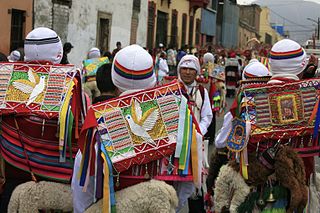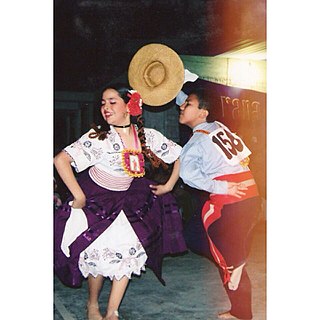 W
WPeruvian dances are primarily of native origin. There are also dances that are related to agricultural work, hunting and war. In Peru dancing bears an important cultural significance. Some choreographies show certain Christian influence.
 W
WThe cachua is a term from Quechua language qhachwa, meaning "round dance," that is the Spanish name for a Latin-American baroque dance form found mainly in Peru. It still exists today as a circle dance. The term was also applied to some villancicos to Spanish texts with cachua rhythm, such as two examples in a report submitted to Charles IV of Spain c.1788-1790. It is in rapid unsyncopated 2/4 time.
 W
WCh'unchu is a folk dance in Peru. It is performed on festivals of the Cusco Region like Mamacha Carmen in Paucartambo and Quyllur Rit'i. Varieties include q'ara ch'unchu, qhapaq ch'unchu and wayri ch'unchu. Its name comes from a derogatory Quechua word for native inhabitants of the Amazon Rainforest.
 W
WThe Danza de las tijeras is an original dance of Chanka origin from the south of the Andes, in Peru. The dance consists of two or more dancers, followed by their respective orchestras of a violin and a harp. The dancers dance in turns, doing explicit moves and challenging steps, such as dancing with just one foot.
 W
WDiablada puneña is a variation of the dance known as diablada performed in the region of Puno, Peru. The origin of this dance is a matter of dispute between Peru and Bolivia, because both nations celebrate the Diablada with similar music, songs, and clothing.
 W
WHuaconada is a ritual dance performed in the village of Mito in the province of Concepción in the central Peruvian Andes. It has been inscribed on the Representative List of the Intangible Cultural Heritage of Humanity by UNESCO in 2010.
 W
WHuayno is a genre of popular Andean music and dance. It is especially common in Peru, Bolivia, and Argentina, but also present in Chile, and is practiced by a variety of ethnic groups, especially the Quechua people. The history of Huayno dates back to colonial Peru as a combination of traditional rural folk music and popular urban dance music. High-pitched vocals are accompanied by a variety of instruments, including quena (flute), harp, siku (panpipe), accordion, saxophone, charango, lute, violin, guitar, and mandolin. Some elements of huayno originate in the music of the pre-Columbian Andes, especially on the territory of the former Inca Empire. Huayno utilizes a distinctive rhythm in which the first beat is stressed and followed by two short beats.
 W
WThe Kullawada, kullahuada, cullaguada or kullawa is a dance practiced in Bolivia and in the Peruvian highlands. The origin and sense of heritage identity of this dance is disputed. The name of the dance probably derives from the word in Aymara language kullakanakawa("they are sisters" in English) and later due to a clipping it would be renamed kullawa. It is represented both in Bolivia, in the Carnival of Oruro; as in Peru, in the Fiesta de la Candelaria.
 W
W W
WMuliza is a traditional music and dance style from Cerro de Pasco, Pasco region, Peru. Other sources mention that it was originated in Tarma, Junín region, disputing both cities the origin of the dance. Popularized at the end of the 19th century, on February 3, 2014 it was declared a national cultural heritage.
 W
WQhapaq negro is a traditional dance in the Cusco Region in Peru. It is performed at festivals such as Mamacha Carmen in Paucartambo, celebrating Our Lady of Mount Carmel. and the Festividad de la Virgen del Rosario in the town of Huallhua, San Salvador District, Calca Province, Cusco Department.
 W
WQhapaq Qulla is a folk dance in Peru. It is performed at festivals of the Cusco Region, such as Mamacha Carmen in Paucartambo and the important Quyllur Rit'i at the Winter Solstice on the mountain Qullqipunku.
 W
WSaqra is a traditional dance in the highlands of the Cusco Region in Peru. The dancers dress as animal figures. This traditional dance has its origins in the late 19th century in the province of Paucartambo, Cusco and was inspired by the sacred paintings of the so called “Mamacha Carmen” also known as the "Virgen del Carmen". Saqra means roguery, restlessness, agility or mischief in English.
 W
WThe Son de los Diablos is an Afro-Peruvian dance that developed as a mixture between African, Spanish, and Amerindian rhythms. Nicomedes Santa Cruz explains that, despite popular opinion, the Son de los Diablos has no links with African rituals or with the Andean Morenada, but rather it has a very slight similarity with the Diabladas of Oruro (Bolivia).
 W
WTinya palla or wiqru palla is a traditional dance of the Pomabamba Province in the Ancash Region in Peru. In 2009 the National Institute of Culture declared tinya palla a National Cultural Heritage of Peru by Resolución Directoral Nacional No. 491/INC-2009.
 W
WTondero is a dance and guitar rhythm from Peru that developed in the country's northern coastal region (Piura–Lambayeque).
 W
WWari is a traditional dance of the Ancash Region in Peru. The dancers are accompanied by musicians who play the tinya and the small pinkuyllu.